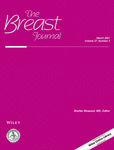EDITORIAL
The significance of accurate diagnosis of encapsulated papillary carcinoma of the breast by core needle biopsy
Shahla Masood MD,
Corresponding Author
Shahla Masood MD
Department of Pathology and Laboratory Medicine, University of Florida College of Medicine – Jax, Jacksonville, FL, USA
Search for more papers by this authorShahla Masood MD,
Corresponding Author
Shahla Masood MD
Department of Pathology and Laboratory Medicine, University of Florida College of Medicine – Jax, Jacksonville, FL, USA
Search for more papers by this authorNo abstract is available for this article.
REFERENCES
- 1Masood S. Core needle biopsy versus fine needle aspiration biopsy: Are there similar sampling and diagnostic issues? In: SG Masood, editor. Clinics in Laboratory Medicine; Contemporary Issues in Breast Cytopathology. Philadelphia, PA: W.B. Saunders; 2005; 25(4): 679-688.
10.1016/j.cll.2005.08.006 Google Scholar
- 2Masood S, Rosa M. Borderline breast lesions: Diagnostic challenges and clinical implications. Adv Anat Pathol. 2011; 18(3): 190-198.
- 3Collins LC, Schnitt SJ. Papillary lesions of the breast: selected diagnostic and management issues. Histopathology. 2008; 52(1): 20-29.
- 4Mulligan AM, O'Malley FP. Papillary lesions of the breast: a review. Adv Anat Pathol. 2007; 14(2): 108-119.
- 5Li X, Xu Y, Ye H, et al. Encapsulated papillary carcinoma of the breast: a clinicopathological study of 49 cases. Curr Probl Cancer. 2018; 42(3): 291-301.
- 6Tse GM, Tan PH, Moriya T. The role of immunohistochemistry in the differential diagnosis of papillary lesions of the breast. J Clin Pathol. 2009; 62(5): 407-413.
- 7Esposito NN, Dabbs DJ, Bhargava R. Are encapsulated papillary carcinomas of the breast in situ or invasive? A basement membrane study of 27 cases. Am J Clin Patho. 2009; 131(2): 228-242.
- 8Rosen PP. Microglandular adenosis. A benign lesion simulating invasive mammary carcinoma. Am J Surg Pathol. 1983; 7(2): 137-144.
- 9Clement PB, Azzopardi JG. Microglandular adenosis of the breast a lesion simulating tubular carcinoma. Histopathology. 1983; 7(2): 169-180.
- 10Tramm T, Kim JY, Tavassoli FA. Diminished number or complete loss of myoepithelial cells associated with metaplastic and neoplastic apocrine lesions of the breast. Am J Surg Pathol. 2011; 35(2): 202-211.
- 11Cserni G. Lack of myoepithelium in apocrine glands of the breast does not necessarily imply malignancy. Histopathology. 2008; 52(1): 239-262.
- 12MacGrogan G, Collins LC, Lerwill M, et at. Encapsulated papillary carcinoma. In: WHO Classification of Tumours Editorial Board. Breast Tumours. Lyon (France): International Agency for Research on Cancer. 2019; 60-62.
- 13Wilkie C, White L, Dupont E, et al. An update of sentinel lymph node mapping in patients with ductal carcinoma in situ. Am J Surg. 2005; 190(4): 563-666.
- 14Rakha EA, Varga Z, Elsheik S, et al. High-grade encapsulated papillary carcinoma of the breast: an under-recognized entity. Histopathology. 2015; 66(5): 740-746.
- 15Mulligan AM, O'Malley FP. Metastatic potential of encapsulated (intracystic) papillary carcinoma of the breast: a report of 2 cases with axillary lymph node micrometastases. Int J Surg Pathol. 2007; 15(2): 143-147.
- 16Jackson CR, Felty CC, Marotti JD, Rosenkranz KM, Muller KE. Encapsulated papillary carcinoma with and without frank invasion: comparison of clinicopathologic features and role of axillary staging. Breast J. 2021; 27(3).
- 17Narod SA, Igball JL, Ginnateas V. Breast cancer mortality after a diagnosis of DCIS. JAMA Onco. 2015; 15(7): 888-896.
- 18Esserman L, Yau C. Rethinking the standard for ductal carcinoma in situ treatment. JAMA Oncol. 2015; 1(7): 881-883.




